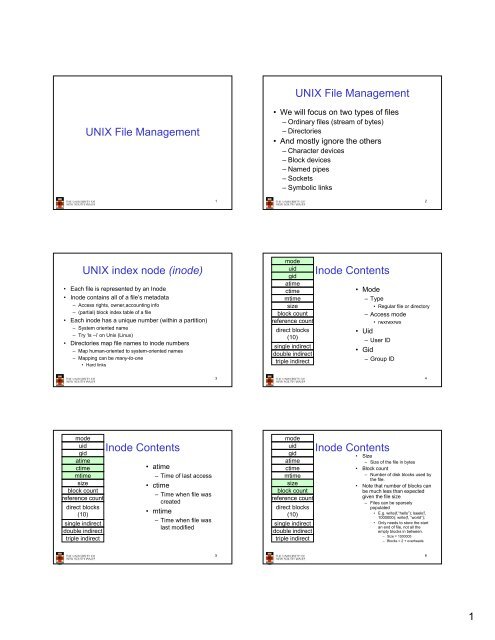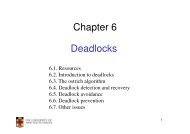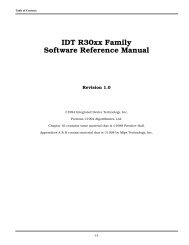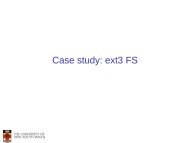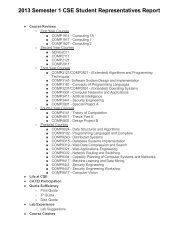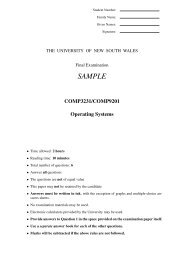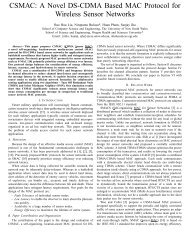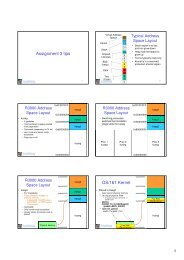inode
inode
inode
Create successful ePaper yourself
Turn your PDF publications into a flip-book with our unique Google optimized e-Paper software.
UNIX File Management<br />
UNIX index node (<strong>inode</strong>)<br />
• Each file is represented by an Inode<br />
• Inode contains all of a file’s metadata<br />
– Access rights, owner,accounting info<br />
– (partial) block index table of a file<br />
• Each <strong>inode</strong> has a unique number (within a partition)<br />
– System oriented name<br />
– Try ‘ls –i’ on Unix (Linux)<br />
• Directories map file names to <strong>inode</strong> numbers<br />
– Map human-oriented to system-oriented names<br />
– Mapping can be many-to-one<br />
• Hard links<br />
mode<br />
uid<br />
gid<br />
atime<br />
ctime<br />
mtime<br />
size<br />
block count<br />
reference count<br />
direct blocks<br />
(10)<br />
single indirect<br />
double indirect<br />
triple indirect<br />
Inode Contents<br />
• atime<br />
– Time of last access<br />
• ctime<br />
– Time when file was<br />
created<br />
• mtime<br />
– Time when file was<br />
last modified<br />
1<br />
3<br />
5<br />
UNIX File Management<br />
• We will focus on two types of files<br />
– Ordinary files (stream of bytes)<br />
– Directories<br />
• And mostly ignore the others<br />
– Character devices<br />
– Block devices<br />
– Named pipes<br />
– Sockets<br />
– Symbolic links<br />
mode<br />
uid<br />
gid<br />
atime<br />
ctime<br />
mtime<br />
size<br />
block count<br />
reference count<br />
direct blocks<br />
(10)<br />
single indirect<br />
double indirect<br />
triple indirect<br />
mode<br />
uid<br />
gid<br />
atime<br />
ctime<br />
mtime<br />
size<br />
block count<br />
reference count<br />
direct blocks<br />
(10)<br />
single indirect<br />
double indirect<br />
triple indirect<br />
Inode Contents<br />
• Mode<br />
– Type<br />
• Regular file or directory<br />
– Access mode<br />
• rwxrwxrwx<br />
• Uid<br />
–User ID<br />
• Gid<br />
– Group ID<br />
Inode Contents<br />
• Size<br />
– Size of the file in bytes<br />
• Block count<br />
– Number of disk blocks used by<br />
the file.<br />
• Note that number of blocks can<br />
be much less than expected<br />
given the file size<br />
– Files can be sparsely<br />
populated<br />
• E.g. write(f,“hello”); lseek(f,<br />
1000000); write(f, “world”);<br />
• Only needs to store the start<br />
an end of file, not all the<br />
empty blocks in between.<br />
– Size = 1000005<br />
– Blocks = 2 + overheads<br />
2<br />
4<br />
6<br />
1
mode<br />
uid<br />
gid<br />
atime<br />
ctime<br />
mtime<br />
size<br />
block count<br />
reference count<br />
direct blocks (10)<br />
40,58,26,8,12,<br />
44,62,30,10,42<br />
single indirect<br />
double indirect<br />
triple indirect<br />
mode<br />
uid<br />
gid<br />
atime<br />
ctime<br />
mtime<br />
size<br />
block count<br />
reference count<br />
direct blocks (10)<br />
40,58,26,8,12,<br />
44,62,30,10,42<br />
single indirect: 32<br />
double indirect<br />
triple indirect<br />
mode<br />
uid<br />
gid<br />
atime<br />
ctime<br />
mtime<br />
size<br />
block count<br />
reference count<br />
direct blocks (10)<br />
40,58,26,8,12,<br />
44,62,30,10,42<br />
single indirect: 32<br />
double indirect<br />
triple indirect<br />
Inode Contents<br />
• Direct Blocks<br />
– Block numbers of first 10<br />
blocks in the file<br />
– Most files are small<br />
• We can find blocks of file<br />
directly from the <strong>inode</strong><br />
0<br />
3<br />
0<br />
56<br />
8<br />
2<br />
9<br />
1<br />
4<br />
5<br />
Disk<br />
7<br />
6<br />
7<br />
63<br />
Inode Contents<br />
• Single Indirect Block<br />
– Block number of a block<br />
containing block numbers<br />
• In this case 8<br />
14<br />
20<br />
28<br />
29<br />
38<br />
46<br />
61<br />
43<br />
0<br />
3<br />
SI<br />
0<br />
56<br />
7<br />
8 4<br />
11<br />
10<br />
2 12 13 7<br />
14<br />
9 17 5 15<br />
1<br />
Disk<br />
16<br />
6<br />
63<br />
Inode Contents<br />
• Double Indirect Block<br />
– Block number of a block<br />
containing block numbers of<br />
blocks containing block<br />
numbers<br />
• Triple Indirect<br />
– Block number of a block<br />
containing block numbers of<br />
blocks containing block<br />
numbers of blocks containing<br />
block numbers ☺<br />
7<br />
9<br />
11<br />
Problem<br />
• How do we store files greater than 10<br />
blocks in size?<br />
– Adding significantly more direct entries in the<br />
<strong>inode</strong> results in many unused entries most of<br />
the time.<br />
Single Indirection<br />
• Requires two disk access to read<br />
– One for the indirect block; one for the target block<br />
• Max File Size<br />
– In previous example<br />
• 10 direct + 8 indirect = 18 block file<br />
– A more realistic example<br />
• Assume 1Kbyte block size, 4 byte block numbers<br />
• 10 * 1K + 1K/4 * 1K = 266 Kbytes<br />
• For large majority of files (< 266 K), only one or<br />
two accesses required to read any block in file.<br />
Unix Inode Block Addressing<br />
Scheme<br />
8<br />
10<br />
12<br />
2
Max File Size<br />
• Assume 4 bytes block numbers and 1K blocks<br />
• The number of addressable blocks<br />
– Direct Blocks = 12<br />
– Single Indirect Blocks = 256<br />
– Double Indirect Blocks = 256 * 256 = 65536<br />
– Triple Indirect Blocks = 256 * 256 * 256 = 16777216<br />
• Max File Size<br />
– 12 + 256 + 65536 + 16777216 = 16843020 = 16 GB<br />
Worst Case Access Patterns with<br />
Unallocated Indirect Blocks<br />
• Worst to write 1 byte<br />
– 4 writes (3 indirect blocks; 1 data)<br />
– 1 read, 4 writes (read-write 1 indirect, write 2; write 1 data)<br />
– 2 reads, 3 writes (read 1 indirect, read-write 1 indirect, write 1;<br />
write 1 data)<br />
– 3 reads, 2 writes (read 2, read-write 1; write 1 data)<br />
• Worst to read 1 byte<br />
– If reading writes an zero-filled block on disk<br />
• Worst case is same as write 1 byte<br />
– If not, worst-case depends on how deep is the current indirect<br />
block tree.<br />
Where/How are Inodes Stored<br />
Boot<br />
Block<br />
Super<br />
Block<br />
Inode<br />
Array<br />
Data Blocks<br />
• System V Disk Layout (s5fs)<br />
– Boot Block<br />
• contain code to bootstrap the OS<br />
– Super Block<br />
• Contains attributes of the file system itself<br />
– e.g. size, number of <strong>inode</strong>s, start block of <strong>inode</strong> array, start of<br />
data block area, free <strong>inode</strong> list, free data block list<br />
– Inode Array<br />
– Data blocks<br />
13<br />
15<br />
17<br />
Some Best and Worst Case<br />
Access Patterns<br />
• To read 1 byte<br />
– Best:<br />
• 1 access via direct block<br />
– Worst:<br />
• 4 accesses via the triple indirect block<br />
• To write 1 byte<br />
– Best:<br />
• 1 write via direct block (with no previous content)<br />
– Worst:<br />
• 4 reads (to get previous contents of block via triple indirect) +<br />
1 write (to write modified block back)<br />
Inode Summary<br />
• The <strong>inode</strong> contains the on disk data associated with a<br />
file<br />
– Contains mode, owner, and other bookkeeping<br />
– Efficient random and sequential access via indexed allocation<br />
– Small files (the majority of files) require only a single access<br />
– Larger files require progressively more disk accesses for random<br />
access<br />
• Sequential access is still efficient<br />
– Can support really large files via increasing levels of indirection<br />
Some problems with s5fs<br />
• Inodes at start of disk; data blocks end<br />
– Long seek times<br />
• Must read <strong>inode</strong> before reading data blocks<br />
• Only one superblock<br />
– Corrupt the superblock and entire file system is lost<br />
• Block allocation suboptimal<br />
– Consecutive free block list created at FS format time<br />
• Allocation and de-allocation eventually randomises the list<br />
resulting the random allocation<br />
• Inodes allocated randomly<br />
– Directory listing resulted in random <strong>inode</strong> access<br />
patterns<br />
14<br />
16<br />
18<br />
3
Berkeley Fast Filesystem (FFS)<br />
• Historically followed s5fs<br />
– Addressed many limitations with s5fs<br />
– Linux mostly similar, so we will focus on Linux<br />
Layout of an Ext2 Partition<br />
Boot<br />
Block<br />
Block Group<br />
0<br />
….<br />
• Disk divided into one or more partitions<br />
• Partition:<br />
– Reserved boot block,<br />
– Collection of equally sized block groups<br />
– All block groups have the same structure<br />
Superblocks<br />
Block Group<br />
n<br />
• Size of the file system, block size and similar<br />
parameters<br />
• Overall free <strong>inode</strong> and block counters<br />
• Data indicating whether file system check is<br />
needed:<br />
– Uncleanly unmounted<br />
– Inconsistency<br />
– Certain number of mounts since last check<br />
– Certain time expired since last check<br />
• Replicated to provide redundancy to add<br />
recoverability<br />
19<br />
21<br />
23<br />
The Linux Ext2 File System<br />
• Second Extended Filesystem<br />
– Evolved from Minix filesystem (via “Extended Filesystem”)<br />
• Features<br />
– Block size (1024, 2048, and 4096) configured as FS creation<br />
– Pre-allocated <strong>inode</strong>s (max number also configured at FS<br />
creation)<br />
– Block groups to increase locality of reference (from BSD<br />
FFS)<br />
– Symbolic links < 60 characters stored within <strong>inode</strong><br />
• Main Problem: unclean unmount e2fsck<br />
Super<br />
Block<br />
– Ext3fs keeps a journal of (meta-data) updates<br />
– Journal is a file where updated are logged<br />
– Compatible with ext2fs<br />
Layout of a Block Group<br />
Group<br />
Descriptors<br />
Data<br />
Block<br />
Bitmap<br />
Inode<br />
Bitmap<br />
Inode<br />
Table<br />
1 blk n blks 1 blk 1 blk m blks k blks<br />
• Replicated super block<br />
– For e2fsck<br />
• Group descriptors<br />
• Bitmaps identify used <strong>inode</strong>s/blocks<br />
• All block have the same number of data blocks<br />
• Advantages of this structure:<br />
– Replication simplifies recovery<br />
– Proximity of <strong>inode</strong> tables and data blocks (reduces seek time)<br />
Group Descriptors<br />
20<br />
Data blocks<br />
• Location of the bitmaps<br />
• Counter for free blocks and <strong>inode</strong>s in this<br />
group<br />
• Number of directories in the group<br />
22<br />
24<br />
4
Performance considerations<br />
• EXT2 optimisations<br />
– Read-ahead for directories<br />
• For directory searching<br />
– Block groups cluster related <strong>inode</strong>s and data blocks<br />
– Pre-allocation of blocks on write (up to 8 blocks)<br />
• 8 bits in bit tables<br />
• Better contiguity when there are concurrent writes<br />
• FFS optimisations<br />
– Files within a directory in the same group<br />
Ext2fs Directories<br />
<strong>inode</strong> rec_len name_len type name…<br />
• Directories are files of a special type<br />
– Consider it a file of special format, managed by the kernel, that<br />
uses most of the same machinery to implement it<br />
• Inodes, etc…<br />
• Directories translate names to <strong>inode</strong> numbers<br />
• Directory entries are of variable length<br />
• Entries can be deleted in place<br />
– <strong>inode</strong> = 0<br />
– Add to length of previous entry<br />
– use null terminated strings for names<br />
Ext2fs Directories<br />
• Note that <strong>inode</strong>s<br />
can have more<br />
than one name<br />
– Called a Hard Link<br />
– Inode (file) 7 has<br />
three names<br />
• “f1” = <strong>inode</strong> 7<br />
• “file2” = <strong>inode</strong> 7<br />
• “f3” = <strong>inode</strong> 7<br />
7<br />
12<br />
2<br />
‘f’ ‘1’ 0 0<br />
7<br />
16<br />
5<br />
‘f’ ‘i’ ‘l’ ‘e’<br />
‘2’ 0 0 0<br />
7<br />
12<br />
2<br />
‘f’ ‘3’ 0 0<br />
0<br />
25<br />
27<br />
Inode No<br />
Rec Length<br />
Name Length<br />
Name<br />
29<br />
Thus far…<br />
• Inodes representing files laid out on disk.<br />
• Inodes are referred to by number!!!<br />
– How do users name files? By number?<br />
– Try ls –i to see how useful <strong>inode</strong> numbers<br />
are….<br />
• “f1” = <strong>inode</strong> 7<br />
• “file2” = <strong>inode</strong> 43<br />
• “f3” = <strong>inode</strong> 85<br />
mode<br />
uid<br />
gid<br />
atime<br />
ctime<br />
mtime<br />
size<br />
block count<br />
reference count<br />
direct blocks (10)<br />
40,58,26,8,12,<br />
44,62,30,10,42<br />
single indirect: 32<br />
double indirect<br />
triple indirect<br />
Ext2fs Directories<br />
7<br />
12<br />
2<br />
‘f’ ‘1’ 0 0<br />
43<br />
16<br />
5<br />
‘f’ ‘i’ ‘l’ ‘e’<br />
‘2’ 0 0 0<br />
85<br />
12<br />
2<br />
‘f’ ‘3’ 0 0<br />
0<br />
26<br />
Inode No<br />
Rec Length<br />
Name Length<br />
Name<br />
Inode Contents<br />
• We can have many name for the same <strong>inode</strong>.<br />
• When we delete a file by name, i.e. remove<br />
the directory entry (link), how does the file<br />
system know when to delete the underlying<br />
<strong>inode</strong>?<br />
– Keep a reference count in the <strong>inode</strong><br />
• Adding a name (directory entry) increments the<br />
count<br />
• Removing a name decrements the count<br />
• If the reference count == 0, then we have no<br />
names for the <strong>inode</strong> (it is unreachable), we can<br />
delete the <strong>inode</strong> (underlying file or directory)<br />
28<br />
30<br />
5
• Deleting a filename<br />
–rmfile2<br />
Ext2fs Directories<br />
7<br />
12<br />
2<br />
‘f’ ‘1’ 0 0<br />
7<br />
16<br />
5<br />
‘f’ ‘i’ ‘l’ ‘e’<br />
‘2’ 0 0 0<br />
7<br />
12<br />
2<br />
‘f’ ‘3’ 0 0<br />
0<br />
Kernel File-related Data<br />
Structures and Interfaces<br />
• We have reviewed how files and<br />
directories are stored on disk<br />
• We know the UNIX file system-call<br />
interface<br />
– open, close, read, write, lseek,…..<br />
• What is in between?<br />
An Option?<br />
Inode No<br />
Rec Length<br />
Name Length<br />
Name<br />
• Use <strong>inode</strong> numbers as file descriptors and<br />
add a file pointer to the <strong>inode</strong><br />
• Problems<br />
– What happens when we concurrently open<br />
the same file twice?<br />
• We should get two separate file descriptors and file<br />
pointers….<br />
31<br />
33<br />
35<br />
• Deleting a filename<br />
–rmfile2<br />
• Adjust the record<br />
length to skip to next<br />
valid entry<br />
Ext2fs Directories<br />
7<br />
32<br />
2<br />
‘f’ ‘1’ 0 0<br />
7<br />
12<br />
2<br />
‘f’ ‘3’ 0 0<br />
0<br />
Inode No<br />
Rec Length<br />
Name Length<br />
Name<br />
What do we need to keep track<br />
of?<br />
• File descriptors<br />
– Each open file has a file descriptor<br />
– Read/Write/lseek/…. use them to specify<br />
which file to operate on.<br />
• File pointer<br />
– Determines where in the file the next read or<br />
write is performed<br />
• Mode<br />
– Was the file opened read-only, etc….<br />
• Single global open<br />
file array<br />
– fd is an index into<br />
the array<br />
– Entries contain file<br />
pointer and pointer<br />
to an <strong>inode</strong><br />
An Option?<br />
fd<br />
fp<br />
i-ptr<br />
32<br />
34<br />
<strong>inode</strong><br />
36<br />
6
• File descriptor 1 is<br />
stdout<br />
– Stdout is<br />
• console for some<br />
processes<br />
• A file for others<br />
• Entry 1 needs to be<br />
different per<br />
process!<br />
Issues<br />
Issue<br />
• Fork<br />
– Fork defines that the child<br />
shares the file pointer with<br />
the parent<br />
• Dup2<br />
– Also defines the file<br />
descriptors share the file<br />
pointer<br />
• With per-process table, we<br />
can only have independent<br />
file pointers<br />
– Even when accessing the<br />
same file<br />
P1 fd<br />
fd<br />
P2 fd<br />
fp<br />
i-ptr<br />
fp<br />
i-ptr<br />
fp<br />
i-ptr<br />
<strong>inode</strong><br />
37<br />
<strong>inode</strong><br />
<strong>inode</strong><br />
Per-Process fd table with global<br />
open file table<br />
• Used by Linux and<br />
most other Unix<br />
operating systems<br />
P1 fd<br />
P2 fd<br />
Per-process<br />
File Descriptor<br />
Tables<br />
f-ptr<br />
f-ptr<br />
f-ptr<br />
fp<br />
i-ptr<br />
fp<br />
i-ptr<br />
Open File Table<br />
39<br />
41<br />
<strong>inode</strong><br />
<strong>inode</strong><br />
Per-process File Descriptor<br />
Array<br />
• Each process has<br />
its own open file<br />
array<br />
– Contains fp, i-ptr etc.<br />
– Fd 1 can be any<br />
<strong>inode</strong> for each<br />
process (console,<br />
log file).<br />
P1 fd<br />
P2 fd<br />
fp<br />
i-ptr<br />
fp<br />
i-ptr<br />
<strong>inode</strong><br />
<strong>inode</strong><br />
Per-Process fd table with global<br />
open file table<br />
• Per-process file descriptor<br />
array<br />
– Contains pointers to open<br />
file table entry<br />
P1 fd<br />
• Open file table array<br />
– Contain entries with a fp<br />
and pointer to an <strong>inode</strong>.<br />
• Provides<br />
– Shared file pointers if<br />
required<br />
– Independent file pointers<br />
if required<br />
P2 fd<br />
• Example:<br />
– All three fds refer to the<br />
same file, two share a file<br />
pointer, one has an Per-process<br />
independent file pointer File Descriptor<br />
Tables<br />
f-ptr<br />
f-ptr<br />
f-ptr<br />
fp<br />
i-ptr<br />
fp<br />
i-ptr<br />
Open File Table<br />
Older Systems only had a single<br />
file system<br />
• They had file system specific open, close, read,<br />
write, … calls.<br />
• The open file table pointed to an in-memory<br />
representation of the <strong>inode</strong><br />
– <strong>inode</strong> format was specific to the file system used<br />
(s5fs, Berkley FFS, etc)<br />
• However, modern systems need to support<br />
many file system types<br />
– ISO9660 (CDROM), MSDOS (floppy), ext2fs, tmpfs<br />
38<br />
40<br />
42<br />
<strong>inode</strong><br />
<strong>inode</strong><br />
7
Supporting Multiple File<br />
Systems<br />
• Alternatives<br />
– Change the file system code to understand<br />
different file system types<br />
• Prone to code bloat, complex, non-solution<br />
– Provide a framework that separates file<br />
system independent and file system<br />
dependent code.<br />
• Allows different file systems to be “plugged in”<br />
• File descriptor, open file table and other parts of<br />
the kernel can be independent of underlying file<br />
system<br />
VFS<br />
architecture<br />
VFS Interface<br />
• Reference<br />
– S.R. Kleiman., "Vnodes: An Architecture for Multiple File System<br />
Types in Sun Unix," USENIX Association: Summer Conference<br />
Proceedings, Atlanta, 1986<br />
– Linux and OS/161 differ slightly, but the principles are the same<br />
• Two major data types<br />
– vfs<br />
• Represents all file system types<br />
• Contains pointers to functions to manipulate each file system as a<br />
whole (e.g. mount, unmount)<br />
– Form a standard interface to the file system<br />
– vnode<br />
• Represents a file (<strong>inode</strong>) in the underlying filesystem<br />
• Points to the real <strong>inode</strong><br />
• Contains pointers to functions to manipulate files/<strong>inode</strong>s (e.g. open,<br />
close, read, write,…)<br />
43<br />
45<br />
47<br />
Virtual File System (VFS)<br />
• Provides single system call interface for many file<br />
systems<br />
– E.g., UFS, Ext2, XFS, DOS, ISO9660,…<br />
• Transparent handling of network file systems<br />
– E.g., NFS, AFS, CODA<br />
• File-based interface to arbitrary device drivers (/dev)<br />
• File-based interface to kernel data structures (/proc)<br />
• Provides an indirection layer for system calls<br />
– File operation table set up at file open time<br />
– Points to actual handling code for particular type<br />
– Further file operations redirected to those functions<br />
The file system independent code<br />
deals with vfs and vnodes<br />
P1 fd<br />
P2 fd<br />
f-ptr<br />
f-ptr<br />
fp<br />
v-ptr<br />
fp<br />
v-ptr<br />
f-ptr<br />
Per-process<br />
File Descriptor<br />
Tables Open File Table<br />
vnode<br />
A look at OS/161’s VFS<br />
The OS161’s file system type<br />
Represents interface to a mounted filesystem<br />
struct fs {<br />
int (*fs_sync)(struct fs *);<br />
const char *(*fs_getvolname)(struct fs *);<br />
struct vnode *(*fs_getroot)(struct fs *);<br />
int (*fs_unmount)(struct fs *);<br />
void *fs_data;<br />
};<br />
Private file system<br />
specific date<br />
Force the<br />
filesystem to<br />
flush its content<br />
to disk<br />
<strong>inode</strong><br />
44<br />
File system<br />
dependent<br />
46 code<br />
Retrieve the<br />
volume name<br />
Retrieve the vnode<br />
associates with the<br />
root of the<br />
filesystem<br />
Unmount the filesystem<br />
Note: mount called via<br />
function ptr passed to<br />
vfs_mount<br />
48<br />
8
Count the<br />
number of<br />
“references”<br />
to this vnode<br />
Vnode<br />
struct vnode {<br />
int vn_refcount;<br />
int vn_opencount;<br />
struct lock *vn_countlock;<br />
struct fs *vn_fs;<br />
void *vn_data;<br />
const struct vnode_ops *vn_ops;<br />
};<br />
Array of pointers<br />
to functions<br />
operating on<br />
vnodes<br />
Pointer to FS<br />
specific<br />
vnode data<br />
(e.g. <strong>inode</strong>)<br />
Number of<br />
times vnode<br />
is currently<br />
open<br />
Lock for mutual<br />
exclusive<br />
access to<br />
counts<br />
Pointer to FS<br />
containing<br />
the vnode<br />
Vnode Ops<br />
struct vnode_ops {<br />
unsigned long vop_magic; /* should always be VOP_MAGIC */<br />
int (*vop_open)(struct vnode *object, int flags_from_open);<br />
int (*vop_close)(struct vnode *object);<br />
int (*vop_reclaim)(struct vnode *vnode);<br />
int (*vop_read)(struct vnode *file, struct uio *uio);<br />
int (*vop_readlink)(struct vnode *link, struct uio *uio);<br />
int (*vop_getdirentry)(struct vnode *dir, struct uio *uio);<br />
int (*vop_write)(struct vnode *file, struct uio *uio);<br />
int (*vop_ioctl)(struct vnode *object, int op, userptr_t data);<br />
int (*vop_stat)(struct vnode *object, struct stat *statbuf);<br />
int (*vop_gettype)(struct vnode *object, int *result);<br />
int (*vop_tryseek)(struct vnode *object, off_t pos);<br />
int (*vop_fsync)(struct vnode *object);<br />
int (*vop_mmap)(struct vnode *file /* add stuff */);<br />
int (*vop_truncate)(struct vnode *file, off_t len);<br />
int (*vop_namefile)(struct vnode *file, struct uio *uio);<br />
Vnode Ops<br />
• Note that most operation are on vnodes. How do<br />
we operate on file names?<br />
– Higher level API on names that uses the internal<br />
VOP_* functions<br />
int vfs_open(char *path, int openflags, struct vnode **ret);<br />
void vfs_close(struct vnode *vn);<br />
int vfs_readlink(char *path, struct uio *data);<br />
int vfs_symlink(const char *contents, char *path);<br />
int vfs_mkdir(char *path);<br />
int vfs_link(char *oldpath, char *newpath);<br />
int vfs_remove(char *path);<br />
int vfs_rmdir(char *path);<br />
int vfs_rename(char *oldpath, char *newpath);<br />
int vfs_chdir(char *path);<br />
int vfs_getcwd(struct uio *buf);<br />
49<br />
51<br />
53<br />
Access Vnodes via Vnode Operations<br />
P1 fd<br />
P2 fd<br />
f-ptr<br />
f-ptr<br />
f-ptr<br />
fp<br />
v-ptr<br />
fp<br />
v-ptr<br />
Open File Table<br />
vnode<br />
<strong>inode</strong><br />
Ext2fs_read<br />
Ext2fs_write<br />
Vnode Ops<br />
Vnode Ops<br />
int (*vop_creat)(struct vnode *dir,<br />
const char *name, int excl,<br />
struct vnode **result);<br />
int (*vop_symlink)(struct vnode *dir,<br />
const char *contents, const char *name);<br />
int (*vop_mkdir)(struct vnode *parentdir,<br />
const char *name);<br />
int (*vop_link)(struct vnode *dir,<br />
const char *name, struct vnode *file);<br />
int (*vop_remove)(struct vnode *dir,<br />
const char *name);<br />
int (*vop_rmdir)(struct vnode *dir,<br />
const char *name);<br />
int (*vop_rename)(struct vnode *vn1, const char *name1,<br />
struct vnode *vn2, const char *name2);<br />
int (*vop_lookup)(struct vnode *dir,<br />
char *pathname, struct vnode **result);<br />
int (*vop_lookparent)(struct vnode *dir,<br />
char *pathname, struct vnode **result,<br />
char *buf, size_t len);<br />
};<br />
Example: OS/161 emufs vnode<br />
ops<br />
/*<br />
* Function table for emufs<br />
files.<br />
*/<br />
static const struct vnode_ops<br />
emufs_fileops = {<br />
VOP_MAGIC, /* mark this a<br />
valid vnode ops table */<br />
emufs_open,<br />
emufs_close,<br />
emufs_reclaim,<br />
emufs_read,<br />
NOTDIR, /* readlink */<br />
NOTDIR, /* getdirentry */<br />
emufs_write,<br />
emufs_ioctl,<br />
emufs_stat,<br />
emufs_file_gettype,<br />
emufs_tryseek,<br />
emufs_fsync,<br />
UNIMP, /* mmap */<br />
emufs_truncate,<br />
NOTDIR, /* namefile */<br />
NOTDIR, /* creat */<br />
NOTDIR, /* symlink */<br />
NOTDIR, /* mkdir */<br />
NOTDIR, /* link */<br />
NOTDIR, /* remove */<br />
NOTDIR, /* rmdir */<br />
NOTDIR, /* rename */<br />
50<br />
52<br />
NOTDIR, /* lookup */<br />
NOTDIR, /* lookparent */<br />
};<br />
54<br />
9
Buffer<br />
Cache<br />
Application<br />
Program<br />
Application<br />
Program<br />
Buffering Disk Blocks<br />
• Allow applications to work with<br />
arbitrarily sized region of a file<br />
Transfer of<br />
arbitrarily<br />
sized regions<br />
of file<br />
Buffers<br />
in Kernel<br />
RAM<br />
– Apps can still optimise for a<br />
particular block size<br />
Transfer of<br />
whole<br />
blocks<br />
4 10<br />
11<br />
12 13 7<br />
14<br />
5 15<br />
16<br />
6<br />
Disk<br />
Buffering Disk Blocks<br />
• Can implement read-ahead by<br />
pre-loading next block on disk<br />
Transfer of<br />
arbitrarily<br />
sized regions<br />
of file<br />
Buffers<br />
in Kernel<br />
RAM<br />
into kernel buffer<br />
– Avoids having to wait until<br />
next read is issued<br />
Transfer of<br />
whole<br />
blocks<br />
4 10<br />
11<br />
12 13 7<br />
14<br />
5 15<br />
16<br />
6<br />
Disk<br />
55<br />
57<br />
59<br />
Buffer<br />
• Buffer:<br />
– Temporary storage used when transferring<br />
data between two entities<br />
• Especially when the entities work at different rates<br />
• Or when the unit of transfer is incompatible<br />
• Example: between application program and disk<br />
Application<br />
Program<br />
Buffering Disk Blocks<br />
• Writes can return immediately<br />
after copying to kernel buffer<br />
Transfer of<br />
arbitrarily<br />
sized regions<br />
of file<br />
Buffers<br />
in Kernel<br />
RAM<br />
– Avoids waiting until write to<br />
disk is complete<br />
– Write is scheduled in the<br />
background<br />
Transfer of<br />
whole<br />
blocks<br />
Cache<br />
4 10<br />
11<br />
12 13 7<br />
14<br />
5 15<br />
16<br />
6<br />
Disk<br />
•Cache:<br />
– Fast storage used to temporarily hold data to<br />
speed up repeated access to the data<br />
• Example: Main memory can cache disk blocks<br />
56<br />
58<br />
60<br />
10
Application<br />
Program<br />
Caching Disk Blocks<br />
• On access<br />
Transfer of<br />
arbitrarily<br />
sized regions<br />
of file<br />
On read<br />
– Hash the<br />
device#, block#<br />
– Check if match in<br />
buffer cache<br />
– Yes, simply use<br />
in-memory copy<br />
– No, follow the<br />
collision chain<br />
– If not found, we<br />
load block from<br />
disk into cache<br />
Cached<br />
blocks in<br />
Kernel<br />
RAM<br />
– Before loading block from disk,<br />
check if it is in cache first<br />
• Avoids disk accesses<br />
• Can optimise for repeated access<br />
for single or several processes<br />
Transfer of<br />
whole<br />
blocks<br />
Unix Buffer Cache<br />
4 10<br />
11<br />
12 13 7<br />
14<br />
5 15<br />
16<br />
6<br />
Disk<br />
File System Consistency<br />
• Paged data is not expected to survive<br />
crashes or power failures<br />
• File data is expected to survive<br />
• Strict LRU could keep critical data in<br />
memory forever if it is frequently used.<br />
61<br />
63<br />
65<br />
Buffering and caching are<br />
related<br />
• Data is read into buffer; extra cache copy<br />
would be wasteful<br />
• After use, block should be put in cache<br />
• Future access may hit cached copy<br />
• Cache utilises unused kernel memory<br />
space; may have to shrink<br />
Replacement<br />
• What happens when the buffer cache is full and<br />
we need to read another block into memory?<br />
– We must choose an existing entry to replace<br />
– Similar to page replacement policy<br />
• Can use FIFO, Clock, LRU, etc.<br />
• Except disk accesses are much less frequent and take longer<br />
than memory references, so LRU is possible<br />
• However, is strict LRU what we want?<br />
– What is different between paged data in RAM and file data in<br />
RAM?<br />
File System Consistency<br />
• Generally, cached disk blocks are prioritised in<br />
terms of how critical they are to file system<br />
consistency<br />
– Directory blocks, <strong>inode</strong> blocks if lost can corrupt the<br />
entire filesystem<br />
• E.g. imagine losing the root directory<br />
• These blocks are usually scheduled for immediate write to<br />
disk<br />
– Data blocks if lost corrupt only the file that they are<br />
associated with<br />
• These block are only scheduled for write back to disk<br />
periodically<br />
• In UNIX, flushd (flush daemon) flushes all modified blocks to<br />
disk every 30 seconds<br />
62<br />
64<br />
66<br />
11
File System Consistency<br />
• Alternatively, use a write-through cache<br />
– All modified blocks are written immediately to disk<br />
– Generates much more disk traffic<br />
• Temporary files written back<br />
• Multiple updates not combined<br />
– Used by DOS<br />
• Gave okay consistency when<br />
– Floppies were removed from drives<br />
– Users were constantly resetting (or crashing) their machines<br />
– Still used, e.g. USB storage devices<br />
67<br />
12


